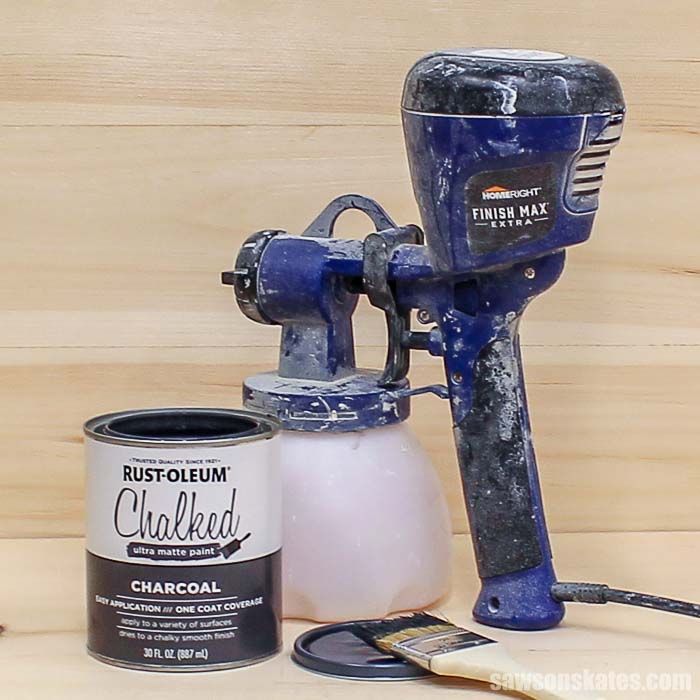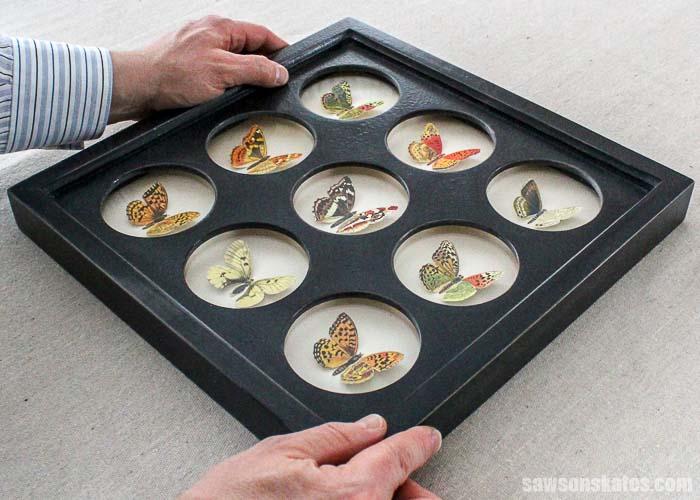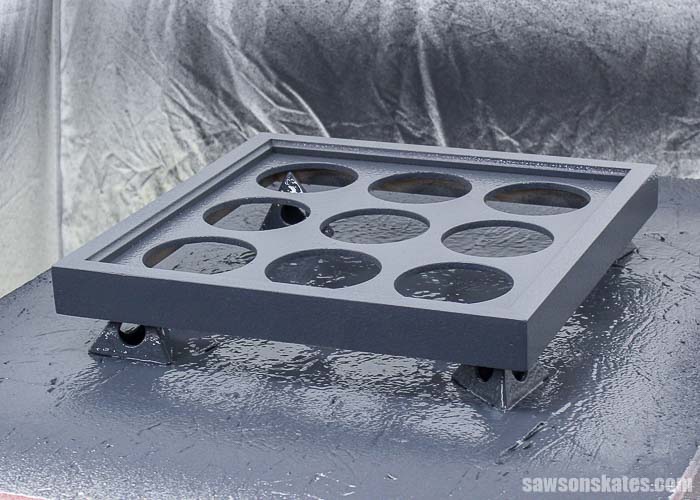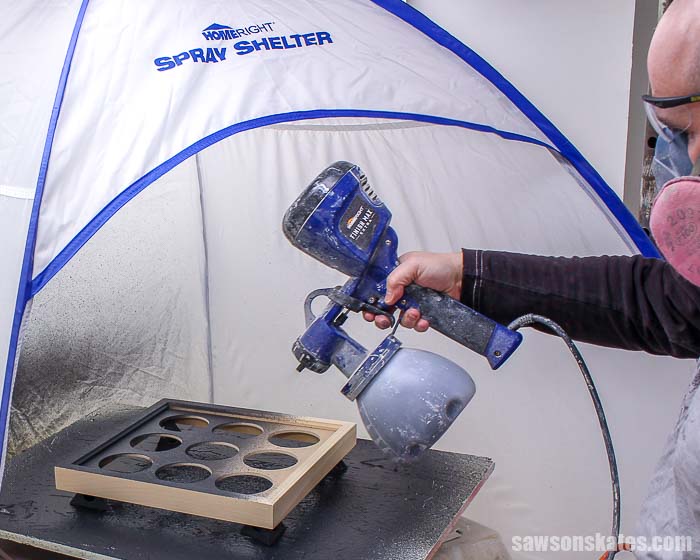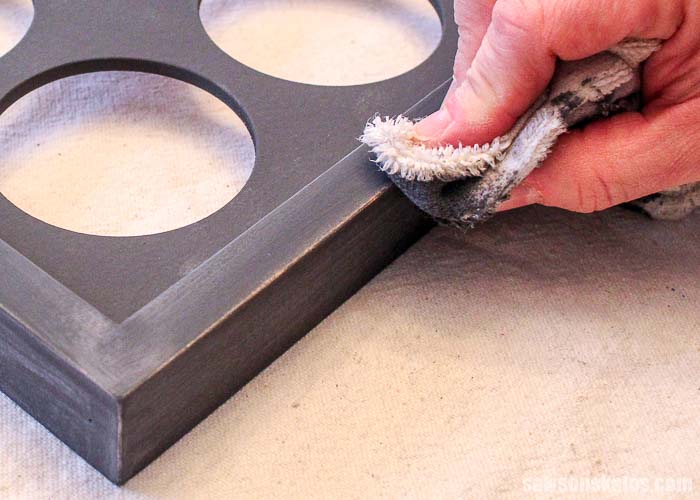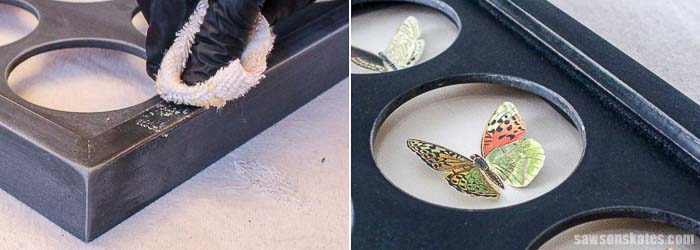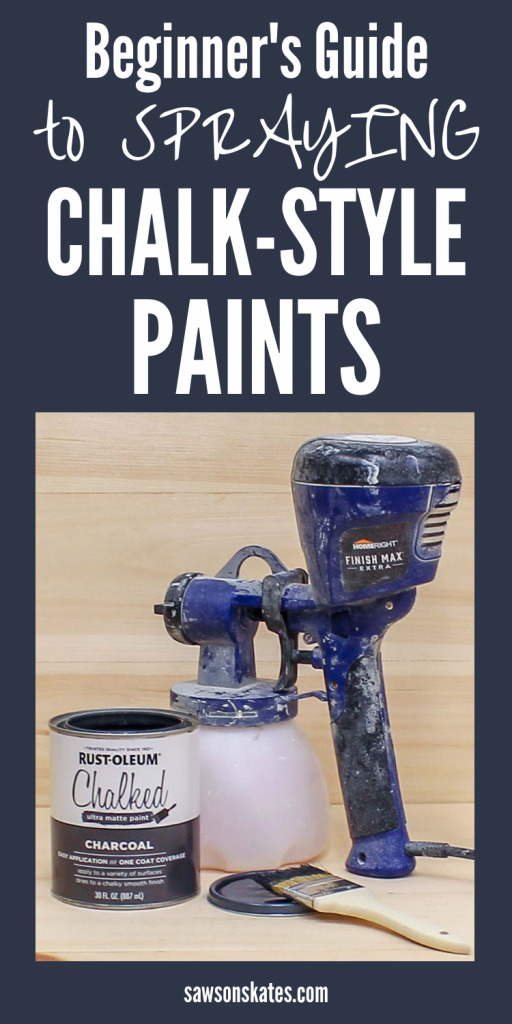The Beginner’s Guide to Spraying Chalk-Style Paint
Spraying chalk-style paint is easy and so much quicker than applying with a paintbrush. All you need is the paint, a paint sprayer, and a spray shelter.
You may also enjoy 7 Ways to Prevent Orange Peel Texture When Using a Paint Sprayer and Spray Polyurethane Rather Than Brush for Professional Looking DIY Furniture.
Spraying chalk-style paint is a quick way to apply paint to small and large projects. Using a paint sprayer eliminates brush marks and gives pieces a smooth finish.
DIY Collage Picture Frames
Recently I shared with you the free plans to make a DIY Collage Picture Frame. The frame features nine spaces for displaying photos of family, friends, pets or even artwork.
I wanted the picture frames to have a slightly worn or distressed look. I’ve heard chalk-style paint is easy to distress, so I thought I would test it out on this project.
Chalk-style paint can be applied with a paintbrush, in fact, I used a brush to paint this DIY corner cabinet. I made the picture frames to give as gifts so I had a dozen frames that needed to be painted. Painting 12 frames with a brush would take forever!
I wondered if I could spray chalk-style paint to speed up the process? For the answer, I turned to my friends Laura and Makayla at HomeRight. Makayla assured me that my “Super Finish Max is great for spraying chalk paint!”, so I decided to give it a try.
What is Chalk Paint®?
Chalk Paint® is a registered trademark of Annie Sloan Interiors Ltd. For the answer to “What is Chalk Paint®?” I went to the Annie Sloan website.
At the Annie Sloan website, I learned Chalk Paint® was first developed in 1990. She wanted a paint that would “work beautifully on furniture without priming or sanding; that would be easy to use and quick to dry; and that could be used for a number of different paint techniques.”
It earned the name Chalk Paint® because of its “velvety, ultra matt finish.”
Where Can You Use Chalk-Style Paint?
We can use chalk-style paint for a variety of furniture projects like tables, cabinets, chairs, dressers and more. We can also use it for projects like the DIY Collage Picture Frames.
The Beginner’s Guide to Spraying Chalk-Style Paint
- Prepare the surface
- Choose your chalk-style paint
- Use a spray shelter to control overspray
- Thin the paint so it will flow properly through the sprayer
- Spray the project and add additional coats if necessary
- If desired, distress the project
- Seal the project to protect the paint
Do You Have to Sand Before Using Chalk-Style Paint?
Chalk-style paint has really great adhesion compared to other types of paints. That means it sticks really well to many different surfaces. Does that mean we don’t have to sand before painting?
In my opinion, a quality finish begins with properly preparing the surface. Properly preparing the surface begins with sanding. To me, no matter what type of paint we’re using we need to sand the surface in order to ensure a professional looking finish.
Related: What’s the Best Sander for Furniture? (Here’s the Answer)
Reasons to Sand Before Applying Chalk-Style Paint
Let’s say we’re giving an old piece of furniture a facelift and the current finish is chipped. If we paint over those chips without sanding the edges of the chips will telegraph into our new finish. In other words, we’ll see indentations from the chips in our new paint. We need to sand first if we want a smooth finish.
Sanding glossy surfaces will help the paint stick even better. If we don’t sand glossy surfaces the chalk-style paint has a greater chance of chipping.
Chalk-style paint sticks really well to raw wood, like the wood I used to make my DIY Collage Picture Frames. My frames were a new project and new wood projects always require a bit of sanding to smooth the surface.
Skate over to 11 Secrets for Sanding Wood Projects Like a Pro for some helpful sanding tips and tricks.
Do You Have to Use a Primer with Chalk-Style Paint?
Primer gives the paint something to “bite” into. Primer helps paint stick better. Chalk-style paint has really great adhesion compared to other types of paints. That means it sticks really well to many different surfaces.
We don’t necessarily need to prime when we use chalk-style paint, but we might want to. Wood knots have a habit of bleeding through the paint. We need to apply a primer if we don’t want to see those knots in our finish.
Skate over to How to Stop Knots from Bleeding Through Paint for some helpful tips and tricks.
Can You Apply Chalk-Style Paint with a Sprayer?
For many our of our projects, we’ll probably want to apply chalk-style paint with a paintbrush. The brush marks add texture to the piece and help to give the project a vintage look. One downside to painting with a brush is that it can be a slow process.
What if we want our project to have a smooth finish? Can we apply the paint with a sprayer? Yes, absolutely! Chalk-style paint can be applied with a paint sprayer.
If we want a smooth finish, without brush marks and we really want to speed up the application process we can apply chalk-style paint with a paint sprayer.
What Do You Need to Spray Chalk-Style Paint?
Chalk-Style Paint
The first thing we’ll need is a chalk-style paint. Annie Sloan is the original creator of Chalk Paint®. Since then several other brands have introduced their own chalk-style paint products.
Rust-Oleum has Chalked their ultra matte finish paint which is available in nine colors. Behr offers Chalk Decorative Paint which is tintable to match your home’s decor.
I chose Rust-Oleum Chalked in the Charcoal color to paint my DIY Collage Picture Frames.
Paint Sprayer
We’ll need a paint sprayer in order to spray our chalk-style paint. I have the HomeRight Super Finish Max paint sprayer and I love it! It’s easy to use, easy to clean and it’s a HUGE timesaver.
I’ve used my HomeRight Super Finish Max paint sprayer for a lot of projects, but I’ve never used it for spraying chalk-style paint. I checked in with my friend Makayla at HomeRight for some tips and she tells me “The Super Finish Max is great for spraying chalk paint!”
The great thing about the Super Finish Max is it comes with three tips and two nozzles. The tips and nozzles allow the Super Finish Max to spray everything from small projects like my DIY collage picture frames and furniture projects to fences and siding.
I used the green tip and black nozzle to spray my DIY Collage Picture Frames.
Control Overspray
One thing we need to be aware of when using a paint sprayer is that there will always be a little overspray. Overspray is paint that sprays past the project. This overspray can cause some issues.
If we’re spraying outdoors the overspray can land on houses and cars. And if it’s windy it can travel pretty far. If we’re spraying indoors the overspray can land on walls and floors.
To control overspray we can use a spray shelter. HomeRight offers a few spray shelters for projects of different sizes. They have a small spray shelter, medium spray shelter, and a large spray shelter.
I set up my medium spray shelter in my small workshop to spray the Rust-Oleum Chalked paint on my DIY Collage Picture Frames.
Other Helpful Paint Spraying Accessories
Eye Protection
Eye protection is a must whether we’re cutting wood or using a paint sprayer. If you don’t believe me just take a look at the paint specks on my sunglasses in the 9 Paint Sprayer Mistakes You Don’t Want to Make post.
Wearing eye protection is a must when using a paint sprayer because we don’t want paint specks in our eyes.
Respirator
Remember those paint specks on my sunglasses? Well, we don’t want to breathe in those paint specks either. So just like we protect our lungs when cutting wood for our DIY furniture projects, we must protect our lungs with a disposable mask or respirator when using a paint sprayer.
Painter’s Pyramids
Painter’s Pyramids are sooo handy! We can set up the painter’s pyramids on our workbench and place our project face down on the pyramids. Then we can spray the back of the project, flip the project and spray the front.
The pyramids allow us to paint projects more quickly, but it also allows us to spray better. With the project raised off of the workbench, we’re able to properly cover the entire project with paint.
Paint Turntable
Think of a paint turntable like a lazy susan for our paint projects. A paint turntable allows us to spin our project so we can reach all surfaces with our paint sprayer.
Drop Cloths
We can use drop cloths to cover surrounding items to add even more protection from paint overspray.
Do You Need to Strain the Paint?
When I talked to my friends at HomeRight about how to prevent orange peel when spraying they suggested straining the paint.
Related: How to Strain Paint
Makayla says straining paint before spraying helps to “remove all air bubbles.” Air bubbles can give the paint a bumpy orange peel finish.
Related: 7 Ways to Prevent Orange Peel Texture When Using a Paint Sprayer
Makayla also has a suggestion if we’re using chalk-style paint powder. She says “make sure you completely stir the paint and get rid of all the powder clumps.” Laura and Makayla painted an armoire with powdered chalk-style paint and some of the clumps of powder weren’t completely stirred in which left little bumps on the surface of the armoire.
How to Thin Chalk-Style Paint for a Sprayer?
What does it mean when we see the term “thinning paint”? Thinning paint literally means to make the paint thinner.
Some paints are very thick. Thick paints do not flow well through paint sprayers. Makayla at HomeRight says “One thing we’ve noticed is that you might need to thin” the chalk-style paint “in order for it to run smoothly through the sprayer.” Makayla went on to say she has noticed “especially white” chalk-style paint requires more thinning for some reason.
What Do You Use to Thin Chalk-Style Paint?
Chalk-style paint is water-based and water-based paint products are thinned with water.
How Much Water do You Use to Thin Chalk-Style Paint?
The instructions for the Rust-Oleum Chalked paint I chose for my DIY Collage Picture Frames says it can be thinned up to 2 ounces of water per quart of paint.
I added 1 tablespoon (about .5 ounces) of water to about 24 ounces of Rust-Oleum Chalked paint.
How Do You Spray Chalk-Style Paint?
Spraying chalk-style paint is so easy, but there are a few things we need to remember when we spray. First, we need to switch the trigger on as we approach the piece and then follow through with a long, continuous movement. We’ll switch the trigger off when the sprayer is beyond the piece.
Long, continuous movements are really important. If we start and stop while spraying the piece we’ll end up with more paint in some areas and less paint in others. For proper paint coverage, we’ll want to overlap each stroke or pass by one third.
We also need to keep our wrist stiff and keep the sprayer about 10″ to 12″ away from the surface we’re spraying. If we bend our wrist as we approach the piece and as we move away from the piece we’ll create an arc.
This means the beginning and end of our stroke will be farther away from the piece than in the middle. In other words, less paint will be applied at the beginning and end of our stroke and more will be applied in the middle. Keeping our wrist stiff means a consistent amount of paint will be applied to the surface.
How Many Coats of Chalk-Style Paint do You Need?
The Rust-Oleum Chalked paint I chose for my DIY Collage Picture Frames says it has one coat coverage for most surfaces. I sprayed one coat of paint on my frames and I was thoroughly impressed with how well it covered.
I could have applied a second coat, but I wanted my frames to have a slightly distressed look, so I didn’t apply any additional coats.
Depending on the look we want for our project the instructions for the Rust-Oleum Chalked paint say one to two additional coats might be needed.
How Long Should You Wait to Apply a Second Coat of Chalk-Style Paint?
The Rust-Oleum Chalked paint dries quickly and a second coat can be applied after about 2 hours.
How Do You Give Chalk-Style Paint a Distressed Look?
Distressing chalk-style paint gives the project an aged or worn look. Some of the paint is removed from areas where the piece would normally show signs of wear or use. These areas included raised surfaces, edges, and corners.
One way we can distress our project is with sandpaper or a sanding sponge. I’ve tried sanding but I felt like I removed too much paint and that my project didn’t look naturally worn.
Instead of sandpaper, I used a wet rag to distress my DIY Collage Picture Frames. The chalk-type paint is easily removed with water. I simply rubbed the areas where I wanted the frame to look worn.
By using a rag I was easily able to control how much paint I removed. All I had to do was rub less if I wanted an area to look less worn or rub more if I wanted an area to look more worn.
How Long Should Chalk-Style Paint Dry Before Distressing
The Rust-Oleum Chalked paint can be sanded or distressed after about 2 hours.
Do You Need to Seal Chalk-Style Paint?
Makayla tells me that we need to seal our chalk-style paint projects. She says the paint “will easily scuff off the surface if it isn’t sealed.”
What Can You Use to Seal Chalk-Style Paint?
Applying wax is one of the most popular ways to seal chalk-style paint. Most brands like Annie Sloan, Rust-Oleum and Behr offer their own waxes to seal their paint.
I had some Minwax Paste Finishing Wax leftover from my DIY corner cabinet, so that’s what I used to seal my DIY Collage Picture Frames.
Applying the wax is easy. I used a rag to apply a thin coat of wax and allowed it to dry for about 10-15 minutes. Then I buffed the wax with a clean rag. The wax leaves our project with a soft, low gloss sheen.
Final Thoughts
Spraying chalk-style paint is easy and so much faster than applying with a paint brush. Spraying is a great way to apply paint to small and large projects. Using a paint sprayer eliminates brush marks and gives pieces a smooth finish.
Thank you for stopping by. If you found this information helpful, would you please pin it to Pinterest? Other DIYers would appreciate it and I would too! Thank you – Scott

